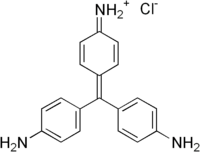Pararosaniline
 |
|
| Names | |
|---|---|
|
IUPAC name
[4-[Bis(4-aminophenyl)methylidene]-1-cyclohexa-2,5-dienylidene]dianiline
|
|
| Other names
Pararosaniline
p-rosaniline C.I. 42500 Para magenta |
|
| Identifiers | |
|
569-61-9 |
|
| 3D model (Jmol) | Interactive image |
| ChEBI |
CHEBI:87663 |
| ChemSpider |
10819 |
| ECHA InfoCard | 100.008.475 |
| KEGG |
C19210 |
| PubChem | 11293 |
| UNII |
20N4C0M8NM |
|
|
|
|
| Properties | |
| C19H17N3 | |
| Molar mass | 287.358 g/mol |
| Appearance | Green crystalline solid |
| Melting point | 268 to 270 °C (514 to 518 °F; 541 to 543 K) decomposes |
| Slightly soluble | |
| Hazards | |
| Safety data sheet | External MSDS |
|
Except where otherwise noted, data are given for materials in their standard state (at 25 °C [77 °F], 100 kPa).
|
|
|
|
|
| Infobox references | |
Pararosaniline, Basic Red 9, or C.I. 42500 is an organic compound with the formula [(H2NC6H4)3C]Cl. It is a magenta solid with a variety of uses as a dye. It is one of the four components of basic fuchsine. (The others are rosaniline, new fuchsine and magenta II.) It is structurally related to other triarylmethane dyes called methyl violets including crystal violet, which feature methyl groups on nitrogen.
It is prepared by the condensation of aniline and para-aminobenzaldehyde. Alternative it arises from the oxidation of 4,4'-bis(aminophenyl)methane in the presence of aniline.
...
Wikipedia
